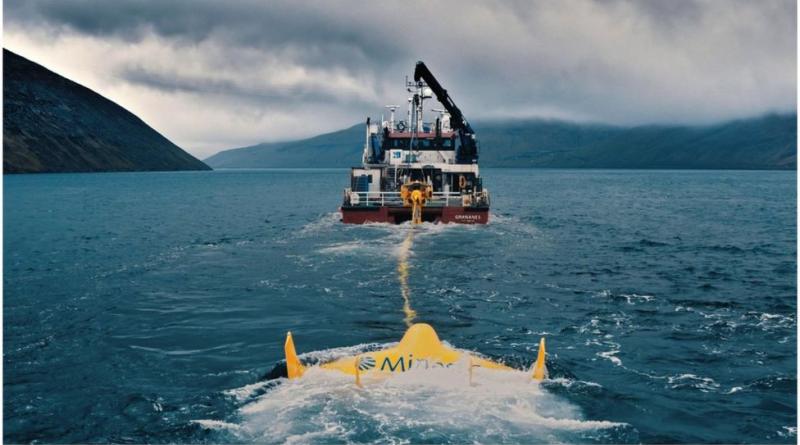Could the UK's tides help wean us off fossil fuels?

Could the ebb and flow of the UK's tides help us to rely less on fossil fuels?
Great progress has been made exploiting wind and solar technology, but if we are going to switch to more renewable power, we need all the energy we can get.
Tidal power represents a huge store of it, and the UK - an island nation which experiences some of the world's most powerful tides - is uniquely well-placed to exploit that resource.
"Tidal power has really significant potential," says Dr Amanda Smyth from the University of Oxford, "yet it has never been developed at scale."
She believes that is set to change.
British companies are at the forefront of the effort to harvest this power of the tide. Designs include an underwater kite that "flies" in the water to maximise the speed the rotors spin.
So, what causes the tides? The tides are driven by the moon. As the Earth turns, the gravity of our nearest celestial neighbour pulls at the water in our oceans, making it bulge out. As the planet turns the moon releases its hold, and the water flows back.
The power of water
Tidal power has great potential because water is such a potent power source. It is nearly 1,000 times more dense than air, so the energy is far more concentrated.
And it has another big advantage over renewable technologies like wind and solar - the tides are predictable.
Wind and solar power are increasingly cheap to deploy, but only work when the sun is shining or the wind is blowing.
Tidal power, on the other hand, can deliver a steady, reliable stream of energy day in, day out.
Studies suggest tidal generation could meet as much as 11% of the UK's annual electricity demand.
The incredible energetic potential of tides was spotted by our medieval forbears.
Woodbridge Tidal Mill in Suffolk has been using tidal energy to mill grain for almost 1,000 years.
Founded in 1170, it uses a dam to capture water when the tide is high. As the tide ebbs the water is released through a sluice, which pushes a water wheel, which turns the grinding stones.
Far bigger dams - or barrages - have been built to generate electricity, notably at La Rance in France in 1966 and at Sihwa Lake in South Korea in 2011.
But damming the flow of water can have devastating environmental impacts. Barrages change the flow of water and how salty it is, which can be very disruptive for plant and animal life.
Fish can be blocked into or out of the lagoons barrages and dams create, and can get caught in the blades of the turbines.
"That's a really important consideration," says Dr Smyth. "Especially when we're thinking about a renewable source of energy that we want to be good for the environment. We do need to consider the full ecosystem impact."
These concerns - and the massive cost - are why a £25bn proposal to build a barrage on the Severn Estuary between Somerset and Wales was rejected a decade ago.
They also explain why the focus of tidal power research has moved to the energy contained in tidal streams - the currents of water created by the rise and fall of the tides.
They run fastest where constrictions, like straits or inlets, funnel the water, increasing the speed of the flow.
The UK is at the forefront of tidal stream research. All sorts of ingenious devices are being tested in the stormy waters off our coasts.
The Orkney Islands, 20 miles to the north of the Scottish mainland, have some of the most extreme tidal streams which is why the European Marine Energy Centre was set up there two decades ago.
The biggest array - and the most straightforward design - is being installed by the Scottish company, MeyGen. Its idea is simple: plant a series of huge turbines on the seafloor so the blades spin as the water flows past. Four have been installed to date, each with three 16m blades.
The Orbital O2 is a very different design. It is an enormous yellow lozenge moored to the seafloor with two giant turbines attached on what look like great wings. The 680-tonne monster floats on the surface with the rotors lowered into the water.
Its makers say it is the most powerful tidal stream turbine in the world and can meet the electricity demand of 2,000 homes.
Venture 180 miles further north to the Faroe Islands and engineers are testing an even more radical concept.
The Minesto "Dragon" uses tidal currents to lift a submersible 'kite'.
If you've ever flown a kite you will know that as it turns in the air it flies faster, even faster than the wind is blowing.
The "Dragon" exploits that effect by 'flying' a turbine underwater in a figure-of-eight.
The device is tethered to the seabed by a cable which also carries the electricity it generates.
The fastest flowing tidal streams tend to be in remote locations and because the equipment used to harvest the power is typically mostly submerged, there tends to be little local opposition.
The turbines don't spin fast enough to offer much of a threat to sealife - says Dr Smyth of Oxford university - but the noise can frighten animals away, restricting their feeding area.
The big issue with all these projects is the cost - they are a very expensive way to generate electricity.
In large part that reflects the engineering challenges of operating in the sea. It is a brutal environment. The waves and currents batter structures and make maintenance very difficult. And salt water is aggressive too, corroding many metals.
But fans of tidal power point to the massive cost reductions achieved in wind and solar technology.
The cost of solar power fell 89% between 2009 and 2019, wind power was down 70% over the same period - though in the last year or so inflation has driven costs up significantly.
Proponents say a similar precipitous fall in the cost of tidal power should be possible as the industry grows.
That said, it will always be pricier than its rivals, warns Dr Danny Coles, a tidal power expert at the University of Plymouth.
"Because tidal turbines are restricted in size due to the depth of water, they will never achieve the sort of economies of scale that wind has been able to achieve," he said.
Predictable power
Operating and maintaining machinery that is totally submerged is even more challenging than it is for offshore wind turbines. So how can it ever be economically feasible? This is where the predictability of the tides comes in.
The uncertainties associated with wind and solar power mean we need to have alternative power supplies in place, just in case. In the UK that is mostly gas-powered plants. Keeping them on standby is expensive.
Come rain or shine, storm or calm, the tides flow in and out like clockwork. It means tidal generators can deliver guaranteed power without any backup. The tidal industry says that levels up the cost.
And, in recognition of the potential of the industry, the government is offering generous subsidies to the companies developing tidal technology.
Eleven tidal stream energy projects secured funding from the UK government last month.
Under the deal, the government guarantees it will buy the electricity they produce for an artificially high price - £198 per megawatt hour.
That is far more than it pays for onshore wind (£52MWh) or solar (£47MWh) - more even than for nuclear power (£90MWh).
The hope is government support will allow the tidal power industry to grow, delivering those cost savings.
Dr Coles is confident significant amounts of the UK's power will be generated from tidal energy industry in 20 years' time.
"That's going to really benefit the energy system as a whole," he says.
But a word of warning: tidal energy is not completely renewable. As the tide rises and falls the oceans' waters pull and push against the seabed. That friction represents a tiny drag on the Earth as it spins. It is one reason the rotation of the planet is gradually slowing, and our days are lengthening.
By increasing the friction on tidal waters, tidal energy systems represent a minute additional drag. But you should not worry unduly, the effect will be infinitesimal.
Scientists estimate tidal drag has increased the length of the day from 21 hours to 24 hours - but the process has taken six hundred million years.
Photo:
MINESTO | An underwater 'kite' that captures tidal power being towed into place





